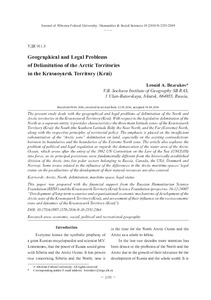Показать сокращенную информацию
Geographical and Legal Problems of Delimitation of the Arctic Territories in the Krasnoyarsk Territory (Krai)
| Автор | Bezrukov, Leonid A. | en |
| Автор | Безруков, Л.А. | ru_RU |
| Дата внесения | 2016-10-31T05:17:46Z | |
| Дата, когда ресурс стал доступен | 2016-10-31T05:17:46Z | |
| Дата публикации | 2016-10 | |
| URI (для ссылок/цитирований) | https://elib.sfu-kras.ru/handle/2311/26362 | |
| Аннотация | The present study deals with the geographical and legal problems of delimitation of the North and Arctic territories in the Krasnoyarsk Territory (Krai). With respect to the legislative delimitation of the North as a separate entity, it provides characteristics the three main latitude zones of the Krasnoyarsk Territory (Krai): the South (the Southern Latitude Belt), the Near North, and the Far (Extreme) North, along with the respective principles of territorial policy. The emphasis is placed on the insufficient substantiation of the “Arctic zone” delimitation on land, especially on the existing contradictions between its boundaries and the boundaries of the Extreme North zone. The article also explores the problem of political and legal regulation as regards the demarcation of the water area of the Arctic Ocean, which arose after the entry of the 1982 UN Convention on the Law of the Sea (UNCLOS) into force, as its principal provisions were fundamentally different from the historically established division of the Arctic into five polar sectors belonging to Russia, Canada, the USA, Denmark and Norway. Some issues related to the influence of the differences in the Arctic maritime spaces’ legal status on the peculiarities of the development of their natural resources are also covered | ru_RU |
| Аннотация | Рассмотрены географические и правовые проблемы делимитации Севера и Арктики Красноярского края. Исходя из законодательного выделения Севера, дана характеристика трех основных широтных зон Красноярского края – Юга (Южного широтного пояса), Ближнего Севера, Дальнего (Крайнего) Севера – и соответствующих им принципов территориальной политики. Указано на недостаточную обоснованность делимитации Арктической зоны на суше, особенно на имеющиеся противоречия между ее границами и границами зоны Крайнего Севера. Раскрыта проблема политико-правовой неурегулированности разграничения акватории Северного Ледовитого океана, возникшая после вступления в силу Конвенции ООН по морскому праву 1982 г., поскольку ее основные положения принципиально не совпадают с исторически сложившимся делением Арктики на пять полярных секторов, принадлежащих России, Канаде, США, Дании и Норвегии. Освещены вопросы влияния различий в правовом статусе морских пространств Арктики на особенности освоения их природных ресурсов | ru_RU |
| Язык | en | en |
| Издатель | Сибирский федеральный университет. Siberian Federal University. | en |
| Тема | Arctic | en |
| Тема | North | en |
| Тема | delimitation | en |
| Тема | maritime space | ru_RU |
| Тема | legal status | en |
| Тема | Арктика | ru_RU |
| Тема | Север | ru_RU |
| Тема | делимитация | ru_RU |
| Тема | морское пространство | ru_RU |
| Тема | правовой статус | ru_RU |
| Название | Geographical and Legal Problems of Delimitation of the Arctic Territories in the Krasnoyarsk Territory (Krai) | en |
| Альтернативное название | Географические и правовые проблемы делимитации арктических территорий Красноярского края | ru_RU |
| Тип | Journal Article | |
| Тип | Published Journal Article | |
| Контакты автора | Bezrukov, Leonid A.:V.B. Sochava Institute of Geography SB RAS, 1 Ulan-Batorskaya, Irkutsk, 664033, Russia; E-mail : bezrukov@irigs.irk.ru | en |
| Контакты автора | Безруков, Л.А.: Институт географии им. В.Б. Сочавы СО РАН, Россия, 664033, Иркутск, ул. Улан-Баторская, 1 | ru_RU |
| Страницы | 2351-2364 | |
| Журнал | Журнал Сибирского федерального университета. Гуманитарные науки. Journal of Siberian Federal University. Humanities & Social Sciences;2016 9 (10) | en |

